MXA’S 2015 SUZUKI RM-Z250 MOTOCROSS TEST: GLASS HALF FULL?
Q: FIRST AND FOREMOST, IS THE 2015 RM-Z250 BETTER THAN THE 2014 RM-Z250?
A: No. If you’re a glass-half-full type of person, then you’ll be happy to learn that the 2015 RM-Z250 isn’t worse than last year’s bike. Why? Suzuki’s engineers copied the 2014 RM-Z250 blueprints line for line in 2015. It is the exact same machine. Oh, don’t get us wrong; there are a few aesthetic changes, but otherwise there is no difference between the two models.
Q: THERE MUST BE SOME MAJOR DIFFERENCES, RIGHT?
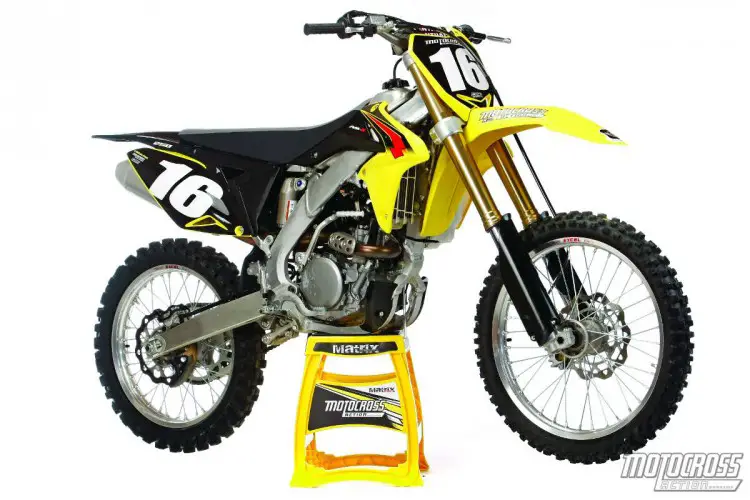
A: Please keep the laughter to a dull roar as we point out the major differences between last year’s RM-Z250 and the 2015 model:
(1) Seat cover. The seat cover is made of the same material, only the red stripe in the middle of the seat has been replaced by a silver one. Fancy.
(2) Plastic guards. Do not be confused; Suzuki didn’t change the shape or durability of its rear-brake rotor guard or lower engine guards. Nope. Instead, the color has been switched from white to black. Thrilling.
(3) BNG. Bold New Graphics grace the RM-Z250, although it will take a keen eye to discern the difference between the two graphic styles. Awesome.
(4) Bar pad. The RM-Z250 again comes with Renthal FatBars, only the handlebar cover is now black instead of red. Riveting.
Q: DO THE LACK OF UPDATES RUIN THE 2015 RM-Z250?
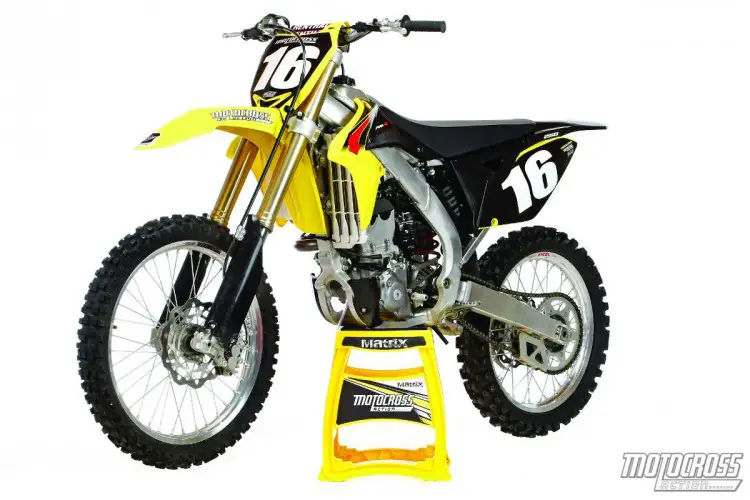
attributes of the RM-Z250. At the top of the list are the cornering characteristics. It can rail through ruts that other bikes can only dream of hitting.
A: It depends on whom you ask. We’ll play the devil’s advocate and view the 2015 Suzuki RM-Z250 from a multitude of angles; however, regardless of whether you are a consumer, a competitor or an MXA test rider, the RM-Z250 is a wounded duck flapping around in a pond during open hunting season.
Consumers: From a consumer’s standpoint, there’s no real advantage to buying a 2015 RM-Z250 when it’s a carbon copy of the 2014 model. Even the scarecrow from “The Wizard of Oz” can understand that it makes more sense to scour dealership floors and buy last year’s model for a fraction of the price. There’s no point in spending the extra dough on a new bike that doesn’t do well on the resale market. Those looking for a new motorcycle will more than likely avoid buying the 2015 RM-Z250; that is, until all 2014 models have evaporated.
Competition: A saving grace for Suzuki is that the other manufacturers didn’t unveil all-new designs for 2015 either—although this is the year of suspension upgrades, with the Honda CRF250, Husqvarna FC250 and KTM 250SXF having radically new fork designs. Engineering-wise, Suzuki dodged the proverbial bullet when its competition kept their same basic layouts from the 2014 model year. However, the competition models are superior to the RM-Z250.
MXA: To our way of thinking, failing to make worthwhile updates doesn’t bode well for a bike that treaded water last year. Let us remind you that the updates to the 2014 RM-Z250 were limited to an ECU change (that even Suzuki couldn’t accurately clarify the benefits of) and yellow side panels.
Forgiveness: While it’s true that the RM-Z250 is a decent motocross bike, it is also an aged design. We forgave Suzuki for their trespasses last year because the bike had a solid powerband and the best cornering characteristics in the class. Now, however, our hearts have hardened. Simply put, the RM-Z250 is good, but not as good as what other manufacturers are producing. That’s a shame, because with a few key changes the bike could be a world-beater like it was in 2011—when it won MXA’s 250 shootout.
Q: WHAT SHOULD SUZUKI HAVE FOCUSED ON FOR 2015?
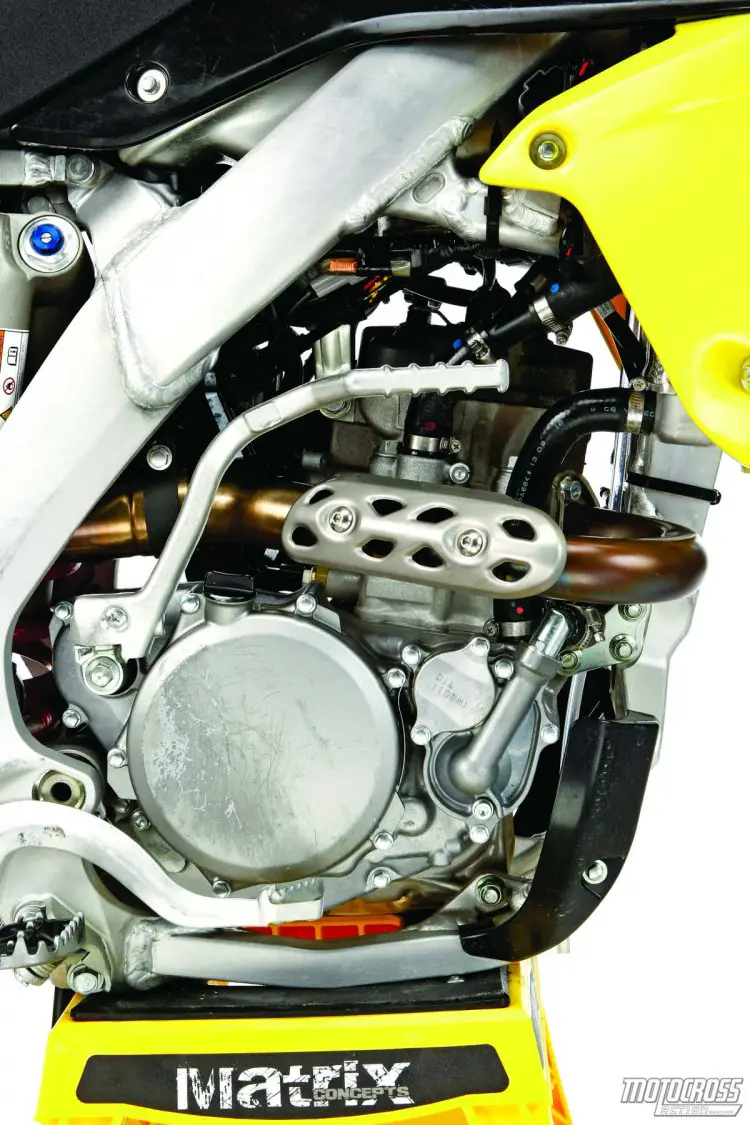
A: Suzuki is quickly losing ground in the arms race. This is what MXA would have done to the 2015 RM-Z250 if we steered the yellow ship:
(1) Engine. The fact that the RM-Z250 reached 39.23 ponies at 12,200 rpm proves that the engine isn’t a slouch. Having said that, it gives up at least 2 horsepower to the KX250F, YZ250F, KTM 250SXF and Husqvarna FC250 at peak. At certain points on the dyno curve, the RM-Z250 falls even farther behind. Given that in the 250 class the most important aspect of a bike is what’s under the cylinder head, Suzuki needs to up the ante—quickly.
(2) Clutch. A problem shared between the RM-Z250 and RM-Z450 is the pitiful clutch. It’s not so much a clutch as it is a ticking time bomb. The entire clutch pack—from the basket to the springs and fibers—is too meager to handle the stress caused by the engine. A better clutch has been at the top of MXA’s RM-Z250 wish list for many years. But, not on Suzuki’s list.
(3) Aesthetics. It sounds trivial, but the RM-Z250 could stand to undergo a facelift. The plastics haven’t changed in six years. Suzuki has attempted to fool the consumer and sidestep the problem by rotating the seat-cover color. When people pony up for a brand-new bike, they want it to look brand new, not like a non-current 2009 model. This is marketing 101.
(4) Hardware. Suzuki needs to get serious about its fasteners. While other manufacturers use robust hardware that stands the test of time, the RM-Z250 uses 8mm bolts of questionable quality. It’s baffling.
(5) Durability. There’s a reason we’re called the “wrecking crew” and not the “ride-once-a-week-for-30-minutes crew.” We batter, bash and punish our fleet of test bikes. We discovered long ago that of all the manufacturers, Suzuki produces motorcycles that consistently have the shortest lifespan. Suzuki needs to take notes from Yamaha and Honda—two brands that put a lot of time and effort into durability testing.
Q: WHAT IS THE BEST ATTRIBUTE OF THE 2015 RM-Z250?
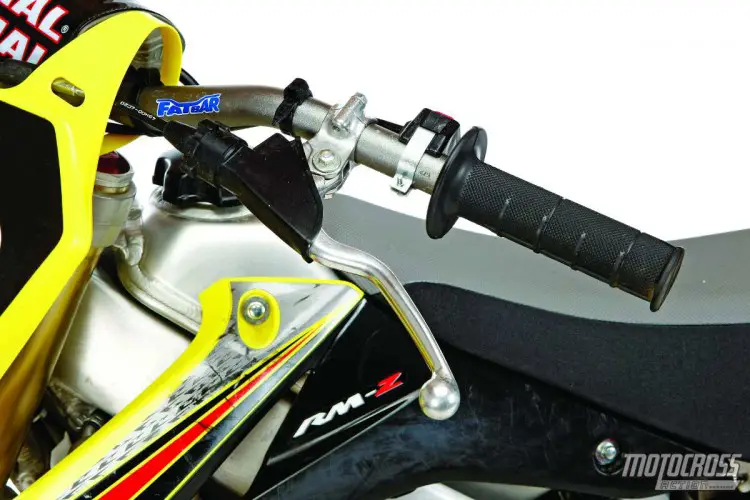
A: We may sound like we are anti-Suzuki, but that isn’t so. Just a few years ago, the RM-Z250 won “MXA’s 250 Four-Stroke Shootout” and, in our minds, it could win again. But, not with a warmed-over product like the 2015 RM-Z250.
Actually, the 2015 RM-Z250 is a very fun bike to ride. In last year’s 250 shootout, it won the cornering category hands down. It cornered so well that MXA test riders were willing to overlook some of its bugaboos. It rails through ruts like a slot car. There is no hesitation at turn-in. Midway through a corner the front end remains planted and secure. Upon exit, there’s no need to give excess input to the handlebars, because the chassis is pointed in the direction that the rider intended. Best of all, the RM-Z250 can hit nearly any line on the track, including spots where there’s no specific rut or ripple to pivot off of. Once the suspension is set up properly and balanced fore and aft, the Suzuki will outperform any other bike through corners. It’s that good. Best of all, there’s no need to dump a judicious amount of money into the RM-Z250 in order to make it corner. Forget different offset triple clamps or longer link arms; Suzuki’s engineers have mastered carving elliptical arcs.
Q: HOW FAST IS THE 2015 RM-Z250?
A: It’s not very fast, but it has a solid delivery. The RM-Z250 doesn’t have the best power in any specific area of the rpm curve, but it has breadth. Bottom-end power is abundant, but really it’s from the low-to-midrange transition that the bike is most impressive. The RM-Z250 does its best work in the midrange; that is to say, from 7500 to 9000 rpm. What’s so advantageous about the power placement is that the midrange is where a rider’s throttle hand spends the most time.
Intermediates and Experts weren’t blown away by the upper reaches of the powerband, because the RM-Z250 has a tendency to sign off rather abruptly. Other bikes, such as the KTM, Husqvarna, Yamaha and Kawasaki, are superior at high rpm. It’s possible to keep the other brands in sight, though, just as long as you shift when the engine demands the next gear. Failing to do so yields an engine that bounces off the rev limiter and slows forward progress to the speed of a snail wearing a weight vest.
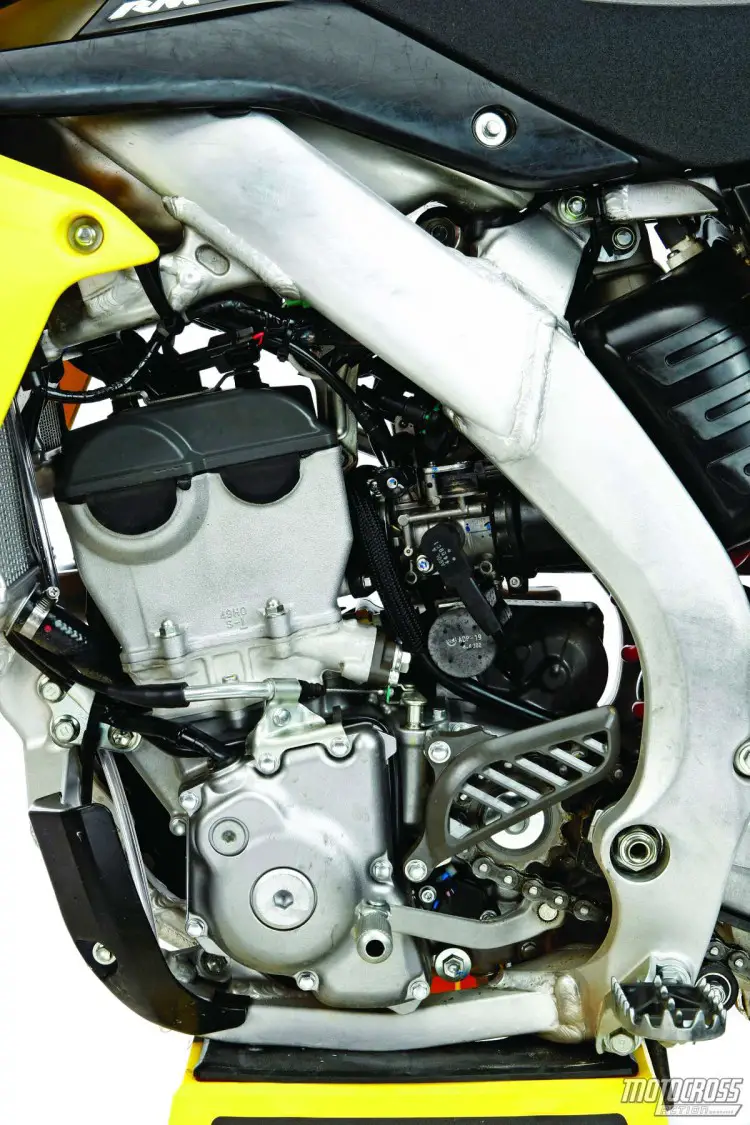
Q: WHAT DID WE DO TO IMPROVE THE 2015 SUZUKI RM-Z250?
A: Find success by making these modifications to the 2015 Suzuki RM-Z250.
(1) Couplers. Optional ignition couplers are now commonplace on 250 four-strokes, but the RM-Z250 paved the way (couplers have come standard on the bike since 2011). The MXA wrecking crew members are fans of having options, and the RM-Z250 couplers actually make a difference to engine performance. We’re particularly fond of the lean (white) coupler, which supercharged the powerplant and provided a more aggressive feel. The rich (gray) coupler detunes the engine to prevent wheelspin on hardpack tracks. A rule of thumb is to run the lean coupler all of the time, except if you’re riding on a surface that’s as hard as a pool table. Note that the RM-Z250 comes with a white coupler out of the crate; however, it is merely a cap to prevent the electronics from getting clogged with dirt. You’ll be able to differentiate the lean coupler from the stock coupler because it has a wire extending out and looping back into the plug.
(2) Clutch. Alongside the Honda CRF250, the RM-Z250 has the sad distinction of having the worst clutch. Those who abuse their clutches will be faced with a Joe-versus-the-volcano scenario when they remove the clutch cover. At the very least, install stiffer aftermarket clutch springs. If you’re interested in nipping the problem in the bud, spend next month’s paycheck on a complete Hinson clutch (www.hinsonracing.com).
(3) Exhaust system. More power has to come from somewhere, and the most logical choice is the exhaust system. You could spend your life’s savings on a high-strung piston, head and cam package, but that only further sacrifices reliability. Instead, invest in an aftermarket exhaust. We’ve had good luck with a host of systems, notably from Yoshimura, Pro Circuit and FMF. A tuned exhaust is a small price to pay for more of what the RM-Z250 needs—power.
(4) Steering stem. Just because the RM-Z250 is the best cornering bike in the class doesn’t mean that it’s the best handling bike. Overall handling performance is not based on cornering alone, but a combination of traits, including straight-line stability, balance at speed and rough ground manners. Unfortunately, the RM-Z250 is not very stable at high speeds or through rough terrain. We always tighten down the steering stem to eliminate free play in the front end. As a rule of thumb, we know that enough free play has been taken out when the front end doesn’t flop easily from side to side.
Q: WHAT DO WE HATE?
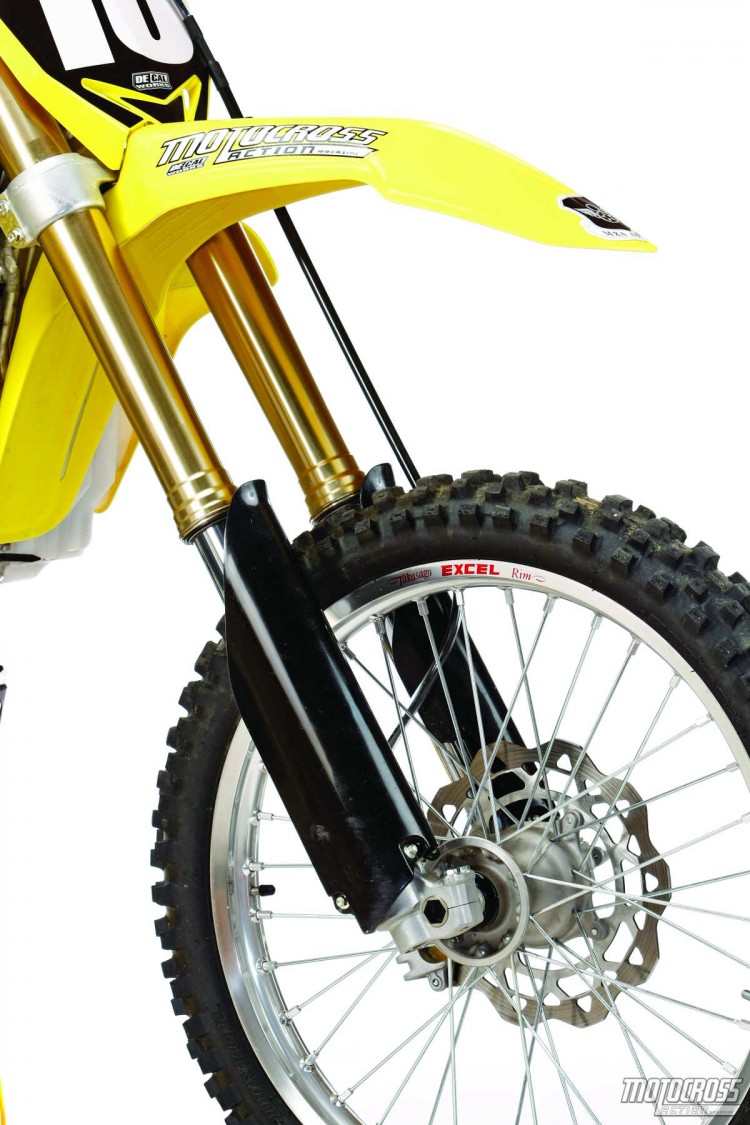
A: The hate list:
(1) Updates. The RM-Z250 was overlooked by Suzuki for 2015. Instead, the focus was placed on the RM-Z450. The fact that the 250 didn’t receive a single quality update is disheartening. Maybe suzuki is saving coin for something special in 2016.
(2) Clutch. What clutch?
(3) Bolts. Maybe it’s just us, but we round off more Suzuki bolts than all the other brands combined.
(4) Brakes. Suzuki must have missed the memo from Honda and Kawasaki announcing that 2015 was the year to go oversize on their previously pitiful brakes.
Q: WHAT DO WE LIKE?
A: The like list:
(1) Cornering. There’s no bike in the 250 class that can hit corners with more precision than the RM-Z250. It’s confidence-inspiring.
(2) Engine. Although we would love Suzuki to kick out the jams with an all-new 250 four-stroke engine (and gain back the power they are giving up to the other players), we still admire the current iteration of the RM-Z250 powerplant. It’s a solid midrange machine.
(3) Couplers. We prefer the white plug-in. Enough said.
(4) Suspension. Showa’s Separate Function Fork (SFF) is very good, especially once it is tuned for your riding style. The SFF is workmanlike, and the shock is designed for a wide range of skill levels and weights.
Q: WHAT DO WE REALLY THINK?
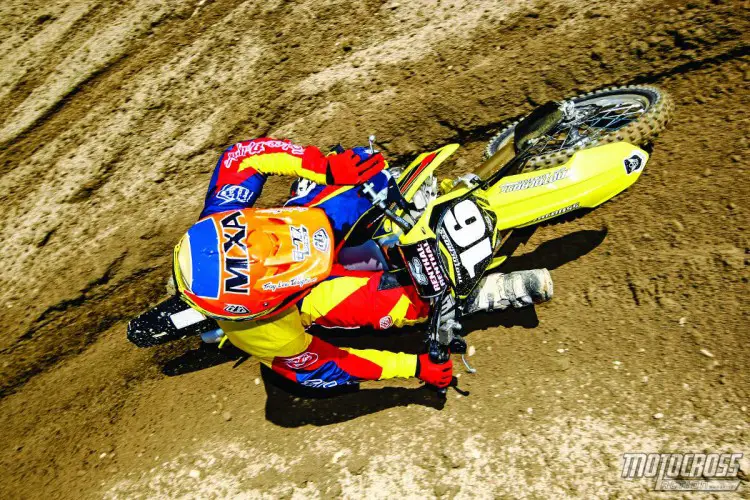
A: It pains the MXA wrecking crew to speak negatively of the 2015 Suzuki RM-Z250. The bike has many good attributes, but several glaring issues need to be addressed before it can once again rise to the top of the 250 four-stroke class. As it sits, the 2015 Suzuki RM-Z250 is a competent entry-level race bike that could win races with tender-loving care (read dollars).
MXA SUZUKI RM-Z250 SETUP SPECS
This is how we set up our 2015 Suzuki RM-Z250 for racing. We offer it as a guide to help you get your own bike dialed in.
SHOWA SFF FORK SETTINGS
In 2013, Suzuki equipped the RM-Z250 with Showa’s Separate Function forks (SFF). We have been pleased with them and admire Suzuki’s willingness to resist the air-fork craze. The SFF forks can accommodate heavier and faster riders, but they might be too stiff for lighter and slower riders. Don’t be afraid to play with oil height and preload. We discovered that cranking in on the preload yielded a better overall feeling.
For hardcore racing, these are MXA’s recommended 2015 Suzuki RM-Z250 fork settings (when changed, stock settings are in parentheses):
Spring rate: 0.99 kg/mm
Oil quantity: 340cc in right leg
Compression: 8 clicks out (11 clicks out)
Rebound: 12 clicks out (9 clicks out)
Preload: 6 clicks out
Fork-leg height: Flush with top clamp
Notes: The RM-Z250 is very sensitive to fork-leg height. We run our forks flush with the top triple clamp to
balance out the chassis and lessen headshake. Note that when the forks are new, they need about an hour of ride time before they properly break in.
SHOWA SHOCK SETTINGS
For hardcore racing, these are MXA’s recommended 2015 Suzuki RM-Z250 fork settings (when changed, stock settings are in parentheses):
Spring rate: 5.5 kg/mm
Race sag: 105mm
Hi-compression: 1-1/2 turns out (2 turns out)
Lo-compression: 12 clicks out (14 clicks out)
Rebound: 12 clicks out (14 clicks out)
Notes: The 5.5 kg/mm spring might be a little stiff for mini-cycle transplants, but use free sag as your gauge. Check the race sag at regular intervals throughout the life of the machine. Don’t discount the shock when it comes to handling. If it is too stiff or the race sag too little, the RM-Z250 can go from a sweet-handling machine to a yellow ogre. Balance the front and rear with careful setup. ❏


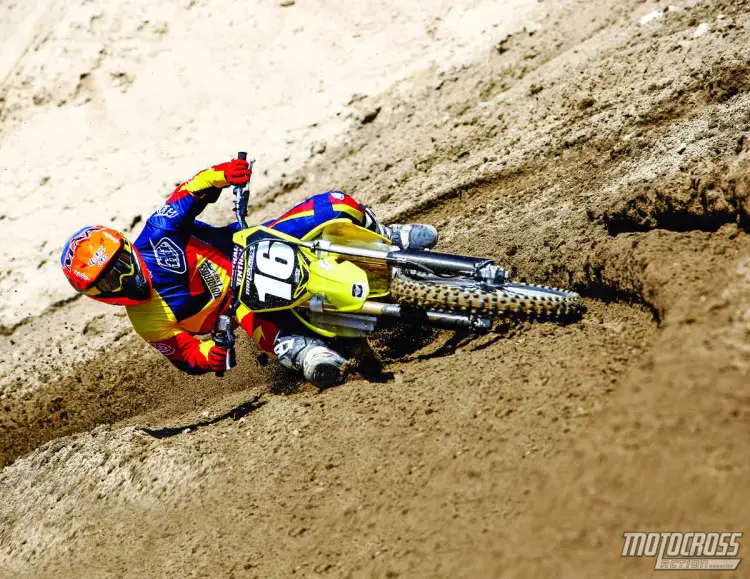


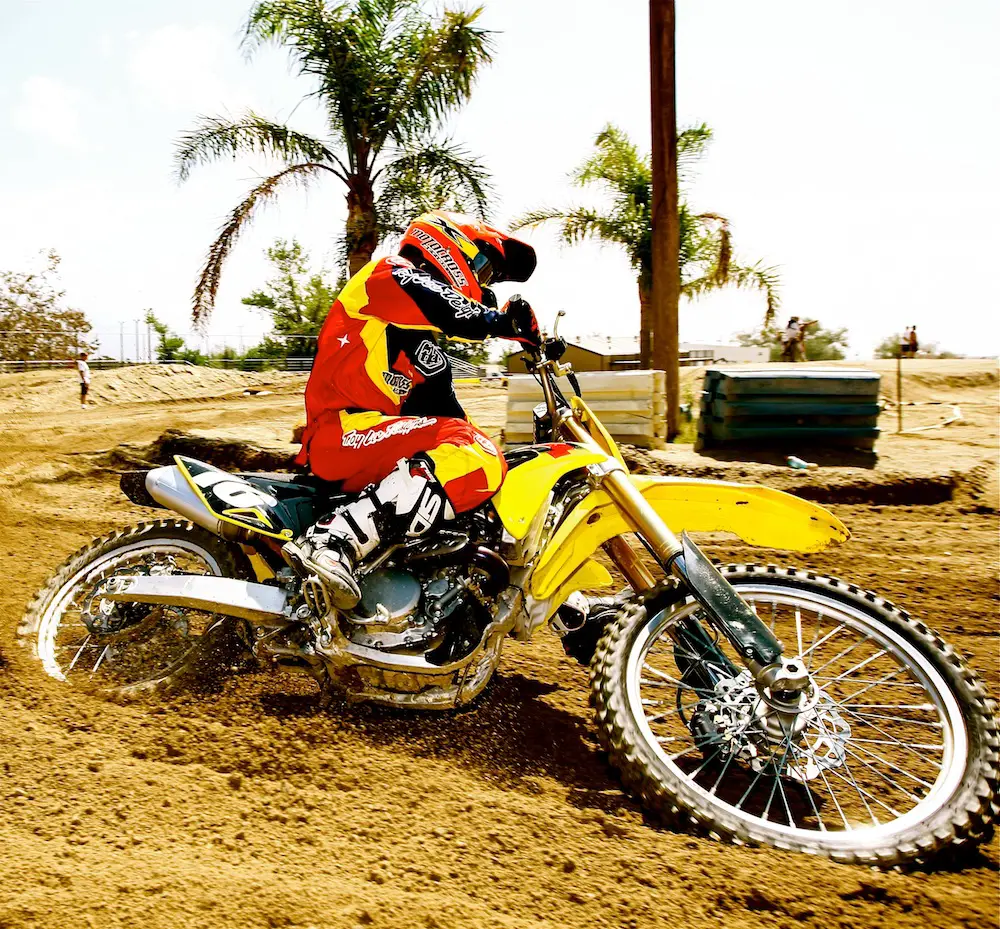



Comments are closed.